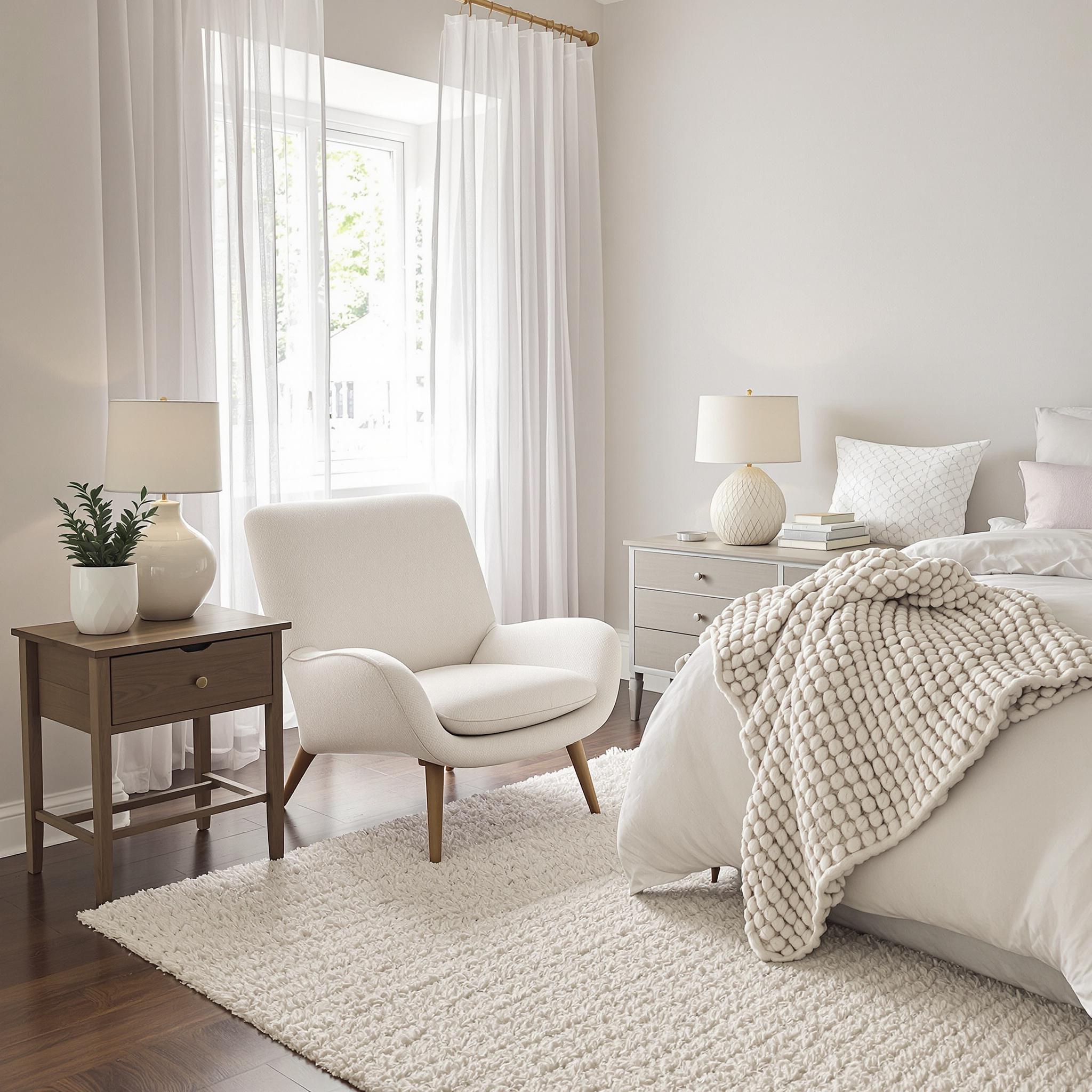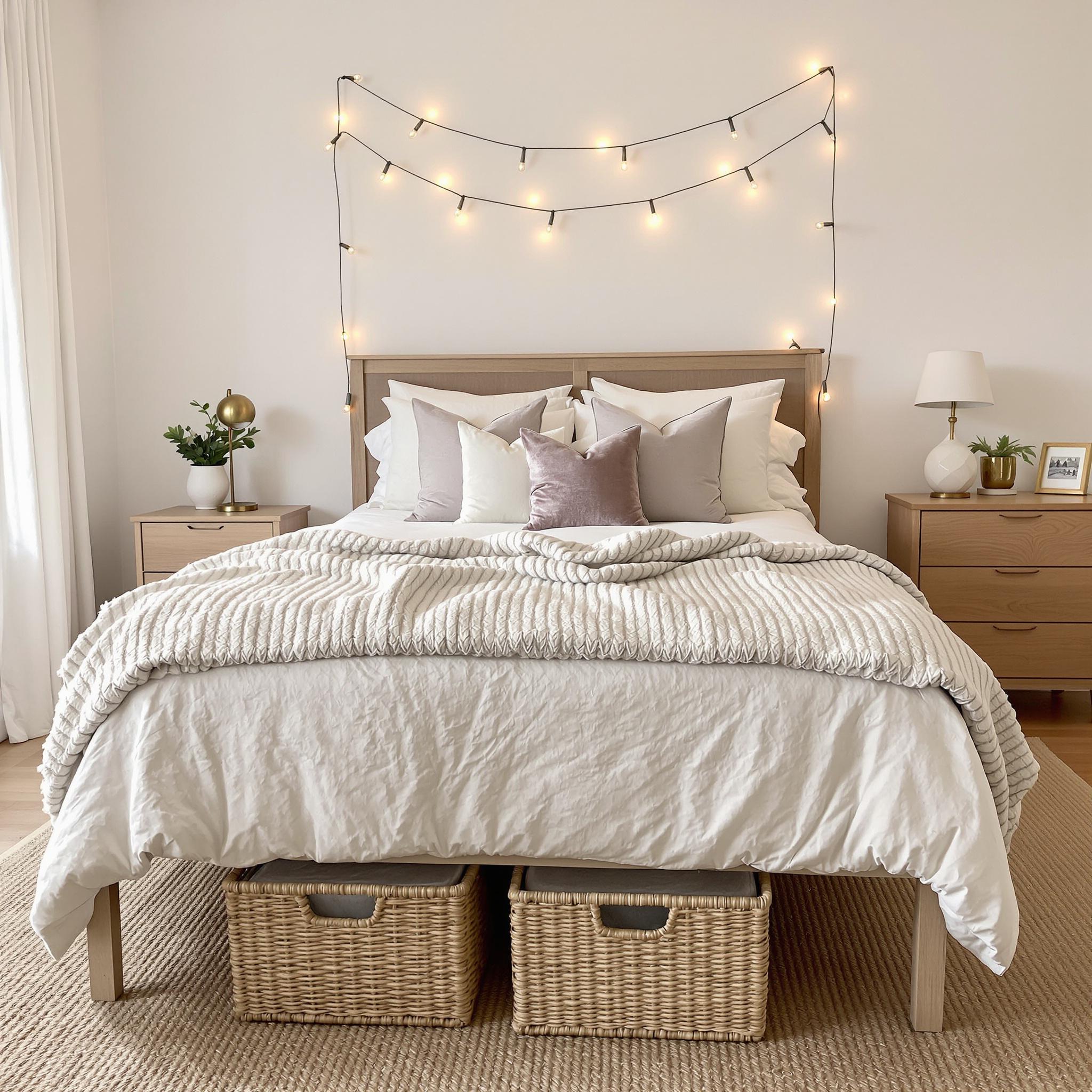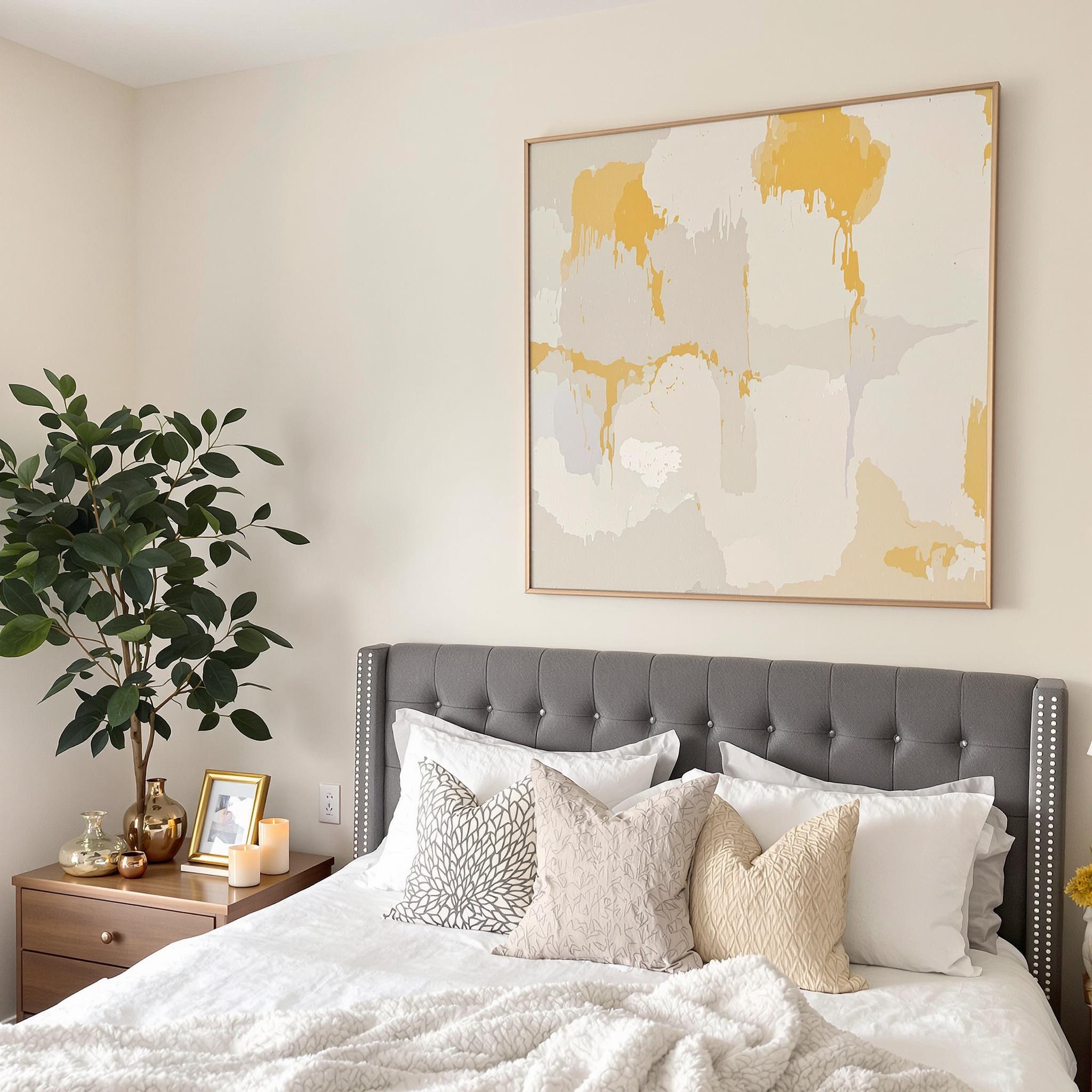Why Neutral Colors Make Bedrooms Feel Calm and Inviting
Neutral tones like beige, gray, and ivory are staples in bedroom design. They create a soothing atmosphere that helps you relax. These colors don’t overwhelm the senses. Instead, they offer a sense of balance and calm.
Think about how a soft beige wall feels compared to a bold red one. The beige invites you to unwind. It doesn’t compete for your attention. This calming effect is why neutral palettes are so popular in bedrooms.
Neutral colors also have psychological benefits. Studies show muted tones reduce stress and promote better sleep. A gray or ivory room can help slow your heart rate. It signals to your brain that it’s time to rest.
My own bedroom has light gray walls. Every night, I notice how peaceful it feels. Friends who visit always comment on its serene vibe. Neutrals truly transform a space into a personal retreat.
How Neutral Tones Adapt to Any Style
One reason neutral decor is timeless is its versatility. Whether you love modern, rustic, or traditional styles, neutrals fit seamlessly. They act as a blank canvas for your creativity.
For example, pair beige walls with sleek furniture for a contemporary look. Add wooden accents for a cozy, rustic feel. Ivory bedding works with both vintage and minimalist designs. The options are endless.
Here’s a quick list of how neutrals adapt:
- Modern: Combine gray walls with clean lines and metal accents.
- Rustic: Use warm beige tones with natural wood textures.
- Traditional: Layer ivory fabrics with ornate details and rich patterns.
Neutrals let you experiment without clashing. You can switch out accessories easily. Swap throw pillows or rugs to refresh the room whenever you want.
Neutral Colors as a Backdrop for Personalization
Neutral tones provide the perfect base for personal touches. They highlight your favorite items instead of competing with them. Bold artwork? It pops against a gray wall. Vibrant rugs? They shine on an ivory floor.
I once added a bright teal lamp to my gray bedroom. The color stood out beautifully. Without the neutral background, the lamp would have gotten lost in the mix.
This adaptability makes neutrals ideal for long-term spaces. Trends come and go, but neutrals stay relevant. You can update your decor without redoing the entire room.
Consider these ideas for personalizing a neutral bedroom:
- Add colorful throw blankets or cushions.
- Hang unique art pieces or photographs.
- Incorporate plants for a touch of greenery.
Each addition reflects your personality while maintaining elegance.
The Timeless Appeal of Neutral Bedroom Decor
Neutral tones never go out of style. Unlike trendy colors, they remain classic year after year. Homeowners and designers alike trust neutrals for their enduring charm.
Take a look at homes from decades past. Beige carpets and ivory walls still look fresh today. These colors age gracefully because they aren’t tied to specific eras.
Another advantage? Neutrals appeal to everyone. If you’re selling your home, a neutral bedroom attracts buyers. It lets them imagine their own style in the space.
Even renters benefit from neutrals. Landlords often choose these colors because they suit any tenant’s taste. You can move in and make the room your own without painting or major changes.
Creating Depth and Interest with Neutral Layers
Some worry neutral rooms might feel boring. But layering shades adds depth and interest. Mixing light and dark neutrals creates a dynamic yet cohesive look.
For instance, pair light gray walls with charcoal bedding. Add a cream rug and ivory curtains. The variety keeps the room engaging without overwhelming it.
Textures also play a key role. A chunky knit blanket or woven baskets brings warmth. Matte finishes contrast nicely with glossy ones. These details elevate the room’s design.
Don’t forget lighting. Soft lamps or string lights enhance neutral tones. They cast a warm glow that makes the space even more inviting.
Choosing the Right Neutral Palette for Your Space
Picking the right neutrals depends on your room’s size and light. Small spaces benefit from lighter shades like ivory or pale beige. They make the area feel larger and airier.
In bigger rooms, darker neutrals like charcoal or taupe work well. They add coziness without feeling cramped. Natural light also affects how colors appear.
Test paint samples before committing. Observe how they look at different times of day. Morning sun might brighten a gray wall, while evening casts a warmer tone.
Balance is key. Too many dark neutrals can feel heavy. Too many light ones might lack depth. Aim for a mix that suits your needs.
Layering Textures: Adding Depth Without Overdoing It
You know that cozy feeling when you walk into a room and just want to stay? That’s often thanks to texture. In neutral bedrooms, texture is key. Without bold colors, textures create interest and comfort.
Layering textures doesn’t mean throwing everything in. You don’t want your bed to look like a textile mess. Pair soft linens with chunky knits or smooth velvet pillows against a woven rug. I once tried faux fur with silk—it was too much. Swapping silk for cotton fixed it.
- Linen sheets: Breathable, durable, and get softer over time.
- Chunky throws: Drape them casually at the foot of the bed for warmth.
- Rattan accents: A rattan chair or basket adds an organic touch without overwhelming.
If you’re worried about going overboard, stick to three main textures per area. Focus on bedding, rugs, and window treatments first.
Furniture Choices: Less Is More, But Not Boring
Picking furniture for a neutral bedroom can be tricky. You don’t want plain pieces that fade away or overly ornate ones that clash. It’s like finding the perfect jeans—not too baggy, not too tight.
I helped my sister pick furniture for her guest room. We chose a sleek oak bed frame paired with a vintage nightstand from a flea market. The mix of old and new gave the room character while keeping it cohesive. Mix and match wisely.
Go for natural finishes like wood, stone, or metal to keep things grounded. Avoid glossy lacquers unless aiming for a modern edge. Use statement pieces sparingly—a unique headboard or sculptural lamp can elevate the room.
- Pick a focal point—a bed, dresser, or reading nook—and build around it.
- Stick to neutral tones for larger pieces; save bold shades for accessories.
- Don’t forget functionality! Comfortable seating or smart storage makes the room livable.
If you love mid-century modern design, consider iconic pieces. A teak credenza or Eames-style chair never goes out of style.
Natural Materials: Bringing the Outdoors In
Bringing nature indoors feels magical. Natural materials like wood, jute, wool, and clay warm up a neutral palette. I added a live-edge wooden shelf to my bedroom, and it transformed the vibe completely.
You don’t need a forest retreat. Subtle touches work wonders. Think woven baskets, ceramic vases with dried flowers, or a small potted plant. Plants purify air and boost moods. Win-win.
People often lean too heavily on synthetic materials. Acrylic and polyester have their place but lack soul. Prioritize sustainable items when possible—it’s better for the planet and your style.
Thrift stores and online marketplaces are great for affordable natural finds. Last year, I got a macramé wall hanging for $15. It’s a hit with friends.
Lighting: Setting the Mood Right
Let’s talk lighting because it makes or breaks a room. Harsh overhead lights? No thanks. Soft, layered lighting? Yes, please. Lighting should enhance calmness, not compete with it.
Start with ambient lighting—ceiling fixtures or dimmable recessed lights. Add task lighting like bedside lamps or sconces. Use accent lighting for artwork or features. I love string lights above the bed—they give a dreamy glow.
Use warm bulbs instead of cool ones. Warm light mimics candlelight, which soothes. Cool light feels clinical. Trust me—I’ve bought the wrong bulbs before, and it ruined the vibe.
Don’t underestimate natural light. Heavy drapes block noise but also sunshine. Use sheer curtains during the day and heavier fabrics at night for privacy.
Patterns and Accents: Keeping Things Interesting
We’ve covered textures, furniture, materials, and lighting. What about patterns and accents? A completely neutral room risks feeling flat. Subtlety is key—they should complement, not dominate.
Start with patterned textiles. Striped throws, geometric pillowcases, or floral duvet covers add personality. I love Moroccan-inspired rugs. Their designs add depth quietly.
For accents, think metallics. Gold, brass, or copper details catch the eye without being flashy. A brass table lamp or decorative bowls work as room jewelry.
Don’t shy away from art. Abstract paintings or black-and-white photos make striking focal points. Keep frames minimalistic for a clean look.
Balancing Simplicity with Sophistication
Designing a neutral bedroom is all about balance. Too simple feels unfinished. Too fancy loses cozy charm. Finding the sweet spot takes intention.
Start with a solid foundation—neutral walls, quality furniture, and good lighting. Add special touches like layered textures, natural materials, subtle patterns, and thoughtful accents. Soon, you’ll have a serene, stylish space.
Sometimes, less really is more. Remember Monica redecorating Rachel’s apartment on *Friends*? Tchotchkes made it chaotic. Keep it simple.
In conclusion, take your time. Designing isn’t about perfection—it’s about creating a sanctuary that reflects you. Experiment, tweak, and enjoy the process.
Accessorizing with Art, Plants, and Metallic Touches: The Finishing Flourishes
Let’s talk about those small details that make a neutral bedroom feel like home. You know, the little things that don’t shout but still show off your personality. Funny enough, it’s often art, plants, and metallic accents that leave the biggest impression.
Art is one of my favorite ways to add character without going overboard. A big piece above your bed or a gallery wall with soft colors can bring warmth. I once found an abstract painting at a flea market. It was mostly beige and gray, but tiny streaks of mustard yellow made it pop. It didn’t clash—it tied the room together. Pro tip: Stick to soft textures or organic shapes if you want to keep things calm.
Plants are another great way to liven up a space. They’re like nature’s decor. A fiddle-leaf fig in the corner or succulents on your nightstand add life without ruining the vibe. Plus, they clean the air. If you’re worried about killing them (been there!), go for low-maintenance options like snake plants or pothos. They’re hard to kill.
Metallic touches? Oh, they’re magic. Think brass lamp bases, copper frames, or a mercury glass vase. These shiny bits catch the light just right, adding elegance. Ever notice how hotel rooms always have gold or silver accents? There’s a reason—they instantly make a space feel fancier.
Experimenting with Statement Pieces: Go Big or Stay Neutral?
Now here’s where it gets fun. Want to shake things up? Add a statement piece. This could be a bold headboard, a vintage rug, or even a unique chair. I swapped my plain wooden bed frame for a tufted velvet one in charcoal gray. It completely changed the room—luxurious yet cozy.
But you don’t have to go all out. Sometimes one standout item is enough. A sculptural chair or patterned pillow can be your “wow” factor. Keep the rest of the room simple so your statement piece stands out.
Here’s a quirky idea: Try a unique mirror. Mirrors aren’t just practical—they’re decorative too. A round, sunburst-style mirror or one with an ornate frame can double as art. Trust me, it’ll grab attention every time someone walks in.
Updating Decor Seasonally: Keep Things Fresh Year-Round
Your bedroom should change with the seasons. No need to repaint the walls four times a year. Small swaps can keep it fresh and inviting.
In spring, switch heavy throws for lighter linens in soft pastels. Add fresh flowers like tulips or lilacs. Summer calls for breezy fabrics and maybe a rattan tray. Fall? Warm tones with amber candles or a faux fur throw. Winter? Layer up with chunky knits and rich textures.
I used to dread changing things because it felt like too much work. Then I realized—you don’t need to redo everything. Swapping a couple of pillows or rearranging books on your nightstand makes a difference. It’s like a mini makeover without the hassle.
Side note: Don’t forget scent. Switching diffusers or candles by season changes the mood. Citrus for summer, spiced scents for fall—you get it.
The Final Takeaway: Less Is More, But Personality Rules
At the end of the day, personalizing a neutral bedroom is about balance. You don’t need to fill every corner or splash color everywhere. Focus on thoughtful additions that reflect who you are while keeping things peaceful. Your bedroom is your sanctuary—it should feel like *you* without overwhelming you.
So go ahead, experiment with art, play around with plants, or find that perfect statement piece. And don’t forget to tweak things seasonally. Your bedroom should grow and change just like you do.
FAQs About Personalizing a Neutral Bedroom
- How do I choose artwork for a neutral bedroom?
Pick pieces that match your palette but add texture or interest. Abstracts, landscapes, or black-and-white photos work well. - What types of plants thrive indoors with minimal care?
Snake plants, pothos, and ZZ plants are great. They handle low light and infrequent watering. - Can I mix metals in my decor?
Yes! Mixing brass and silver adds interest. Just stick to a consistent style, like modern or vintage. - What makes a good statement piece?
Something large, unique, or unexpected—a bold headboard, striking mirror, or unusual furniture. - How often should I update my decor?
Seasonal updates are ideal, but small changes every few months keep things fresh. - Is it okay to use bright colors in a neutral room?
Sure, but use them sparingly. Bright pillows or artwork add balance without overwhelming. - Where can I find affordable decor items?
Check thrift stores, flea markets, or online platforms like Etsy or Facebook Marketplace. - How do I avoid clutter in a personalized space?
Edit ruthlessly. Only keep items that mean something or serve a purpose. Use baskets for storage. - Should I match my bedding to my walls?
Not really. Complementary colors or patterns create harmony without being too matchy. - What’s the easiest way to refresh a neutral bedroom?
Swap textiles like rugs, curtains, or throw blankets. It’s an instant update with little effort.



